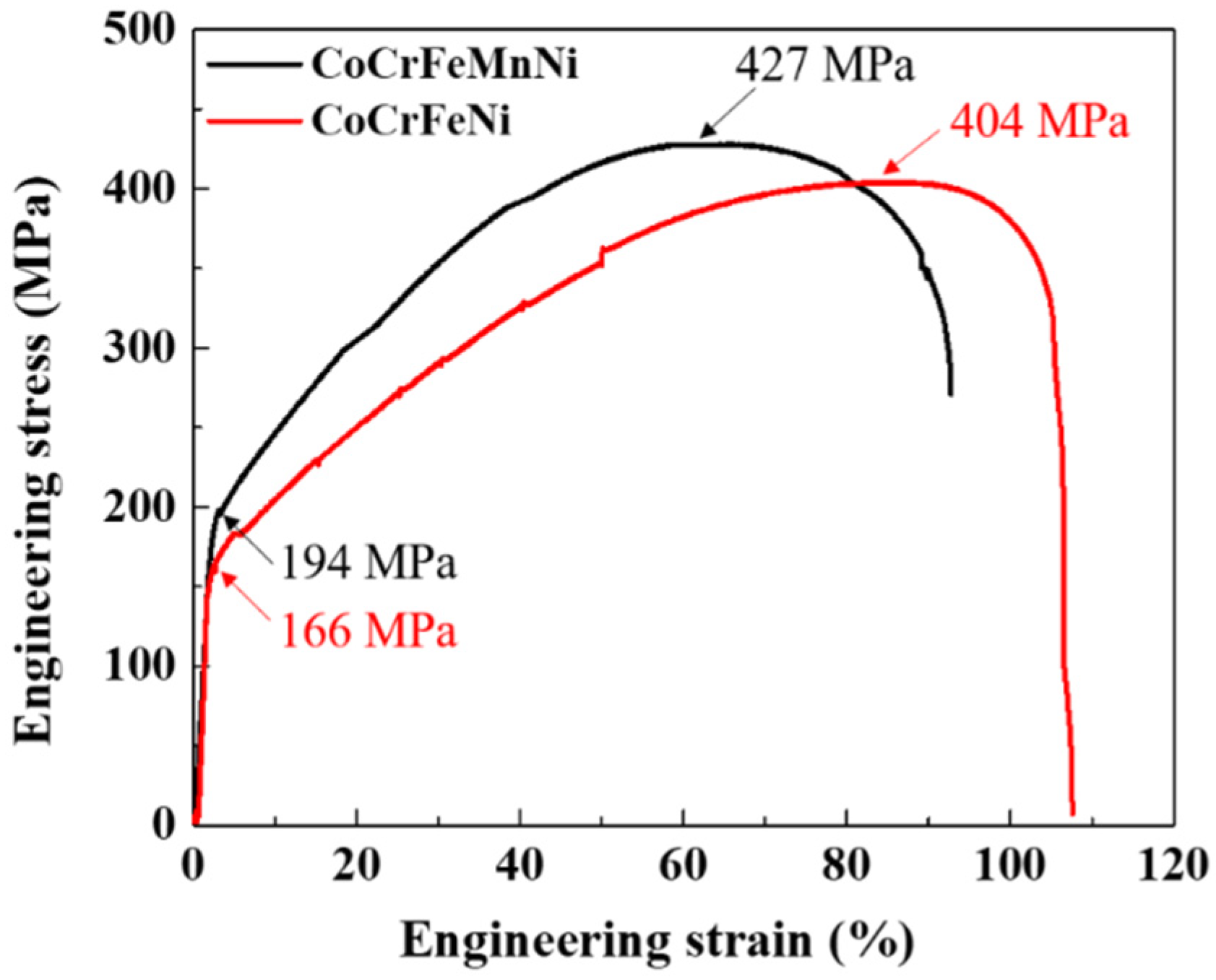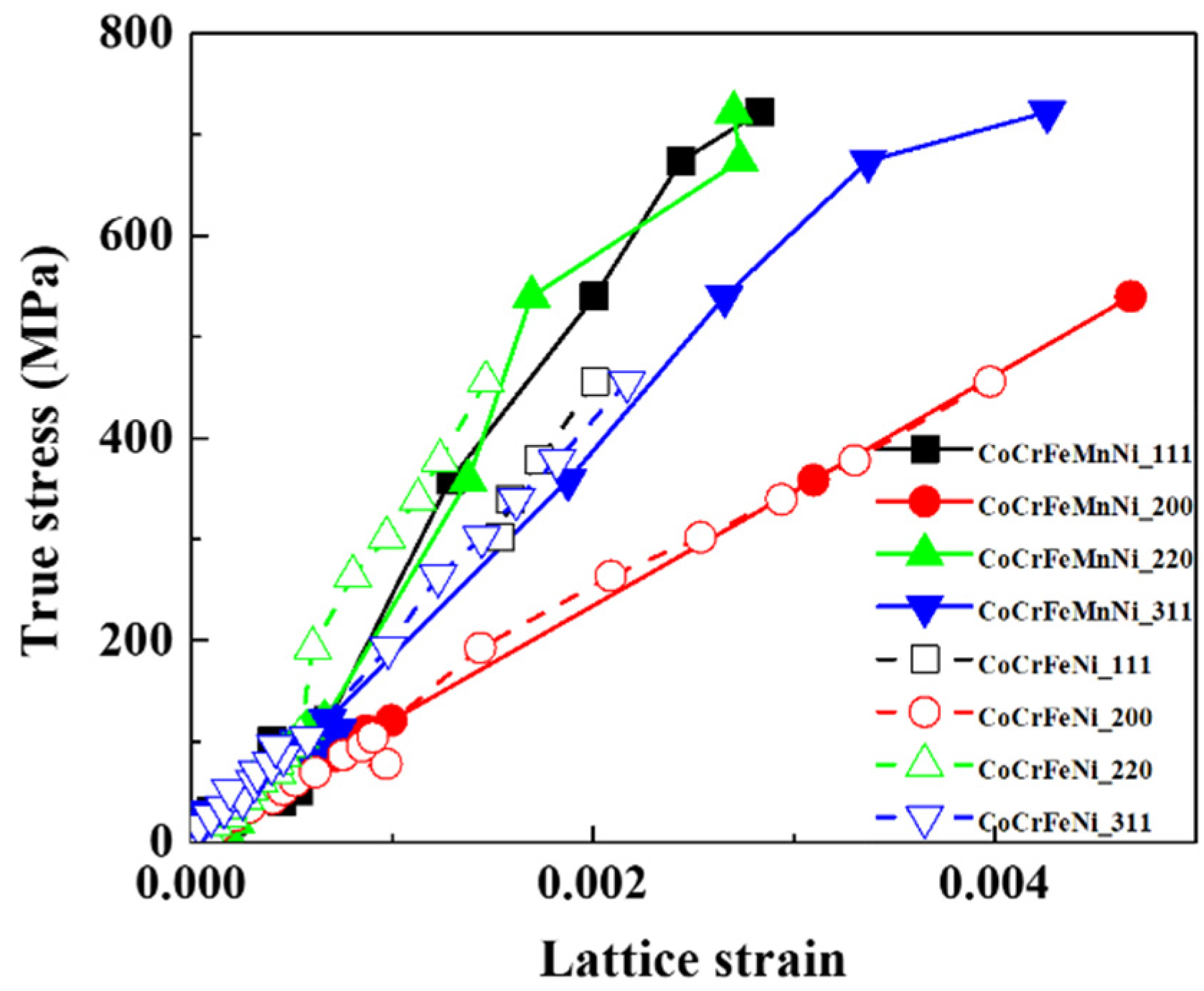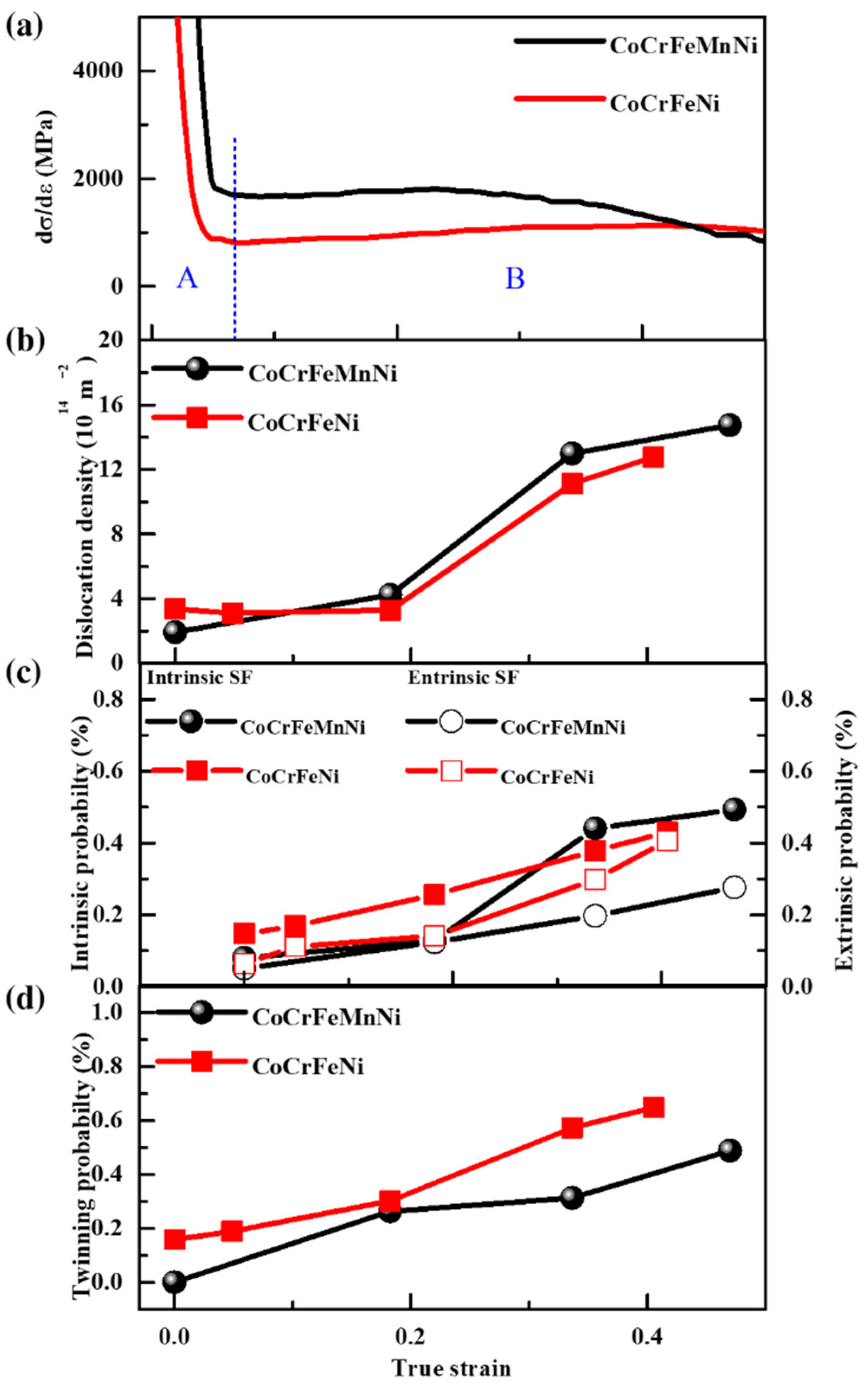Tensile Response of As-Cast CoCrFeNi and CoCrFeMnNi High-Entropy Alloys
Abstract
:1. Introduction
2. Materials and Methods
3. Results
3.1. Tensile Properties
3.2. Lattice Strain Evolution
3.3. Microstructural Evolutions during Tensile Straining
4. Discussion
5. Conclusions
Supplementary Materials
Author Contributions
Funding
Data Availability Statement
Acknowledgments
Conflicts of Interest
References
- Yeh, J.W.; Chen, S.K.; Lin, S.J.; Gan, J.Y.; Chin, T.S.; Shun, T.T.; Tsau, C.H.; Chang, S.Y. Nanostructured High-Entropy Alloys with Multiple Principal Elements Novel Alloy Design Concepts and Outcomes. Adv. Eng. Mater. 2004, 6, 299–303. [Google Scholar] [CrossRef]
- Cantor, B.; Chang, I.T.H.; Knight, P.; Vincent, A.J.B. Microstructural development in equiatomic multicomponent alloys. Mater. Sci. Eng. A 2004, 375–377, 213–218. [Google Scholar] [CrossRef]
- Zhang, Y.; Zuo, T.T.; Tang, Z.; Gao, M.C.; Dahmen, K.A.; Liaw, P.K.; Lu, Z.P. Microstructures and properties of high-entropy alloys. Prog. Mater. Sci. 2014, 61, 1–93. [Google Scholar] [CrossRef]
- Miracle, D.B.; Senkov, O.N. A critical review of high entropy alloys and related concepts. Acta Mater. 2017, 122, 448–511. [Google Scholar] [CrossRef] [Green Version]
- Gludovatz, B.; Hohenwarter, A.; Catoor, D.; Chang, E.H.; George, E.P.; Ritchie, R.O. A fracture-resistant high-entropy alloy for cryogenic applications. Science 2014, 345, 1153–1158. [Google Scholar] [CrossRef] [Green Version]
- Gludovatz, B.; Hohenwarter, A.; Thurston, K.V.; Bei, H.; Wu, Z.; George, E.P.; Ritchie, R.O. Exceptional damage-tolerance of a medium-entropy alloy CrCoNi at cryogenic temperatures. Nat. Commun. 2016, 7, 10602. [Google Scholar] [CrossRef]
- Miao, J.; Slone, C.E.; Smith, T.M.; Niu, C.; Bei, H.; Ghazisaeidi, M.; Pharr, G.M.; Mills, M.J. The evolution of the deformation substructure in a Ni-Co-Cr equiatomic solid solution alloy. Acta Mater. 2017, 132, 35–48. [Google Scholar] [CrossRef]
- Wang, B.; He, H.; Naeem, M.; Lan, S.; Harjo, S.; Kawasaki, T.; Nie, Y.; Kui, H.W.; Ungár, T.; Ma, D.; et al. Deformation of CoCrFeNi high entropy alloy at large strain. Scr. Mater. 2018, 155, 54–57. [Google Scholar] [CrossRef]
- Wu, Z.; Bei, H.; Pharr, G.M.; George, E.P. Temperature dependence of the mechanical properties of equiatomic solid solution alloys with face-centered cubic crystal structures. Acta Mater. 2014, 81, 428–441. [Google Scholar] [CrossRef]
- Yao, M.J.; Pradeep, K.G.; Tasan, C.C.; Raabe, D. A novel, single phase, non-equiatomic FeMnNiCoCr high-entropy alloy with exceptional phase stability and tensile ductility. Scr. Mater. 2014, 72–73, 5–8. [Google Scholar] [CrossRef]
- Otto, F.; Dlouhý, A.; Somsen, C.; Bei, H.; Eggeler, G.; George, E.P. The influences of temperature and microstructure on the tensile properties of a CoCrFeMnNi high-entropy alloy. Acta Mater. 2013, 61, 5743–5755. [Google Scholar] [CrossRef] [Green Version]
- Joo, S.H.; Kato, H.; Jang, M.J.; Moon, J.; Tsai, C.W.; Yeh, J.W.; Kim, H.S. Tensile deformation behavior and deformation twinning of an equimolar CoCrFeMnNi high-entropy alloy. Mater. Sci. Eng. A 2017, 689, 122–133. [Google Scholar] [CrossRef]
- Shabani, M.; Indeck, J.; Hazeli, K.; Jablonski, P.D.; Pataky, G.J. Effect of Strain Rate on the Tensile Behavior of CoCrFeNi and CoCrFeMnNi High-Entropy Alloys. J. Mater. Eng. Perform. 2019, 28, 4348–4356. [Google Scholar] [CrossRef] [Green Version]
- Huo, W.; Zhou, H.; Fang, F.; Hu, X.; Xie, Z.; Jiang, J. Strain-rate effect upon the tensile behavior of CoCrFeNi high-entropy alloys. Mater. Sci. Eng. A 2017, 689, 366–369. [Google Scholar] [CrossRef]
- Lam, T.-N.; Tsai, C.-W.; Chen, B.-K.; Lai, B.-H.; Liu, H.-C.; Kawasaki, T.; Harjo, S.; Lin, B.-H.; Huang, E.W. Element Effects of Mn and Ge on the Tuning of Mechanical Properties of High-Entropy Alloys. Metall. Mater. Trans. A 2020, 51, 5023–5028. [Google Scholar] [CrossRef]
- Ding, Q.; Zhang, Y.; Chen, X.; Fu, X.; Chen, D.; Chen, S.; Gu, L.; Wei, F.; Bei, H.; Gao, Y.; et al. Tuning element distribution, structure and properties by composition in high-entropy alloys. Nature 2019, 574, 223–227. [Google Scholar] [CrossRef] [PubMed]
- Laplanche, G.; Kostka, A.; Horst, O.M.; Eggeler, G.; George, E.P. Microstructure evolution and critical stress for twinning in the CrMnFeCoNi high-entropy alloy. Acta Mater. 2016, 118, 152–163. [Google Scholar] [CrossRef] [Green Version]
- Gludovatz, B.; George, E.P.; Ritchie, R.O. Processing, Microstructure and Mechanical Properties of the CrMnFeCoNi High-Entropy Alloy. JOM 2015, 67, 2262–2270. [Google Scholar] [CrossRef]
- Thurston, K.V.S.; Gludovatz, B.; Hohenwarter, A.; Laplanche, G.; George, E.P.; Ritchie, R.O. Effect of temperature on the fatigue-crack growth behavior of the high-entropy alloy CrMnFeCoNi. Intermetallics 2017, 88, 65–72. [Google Scholar] [CrossRef]
- Thurston, K.V.S.; Gludovatz, B.; Yu, Q.; Laplanche, G.; George, E.P.; Ritchie, R.O. Temperature and load-ratio dependent fatigue-crack growth in the CrMnFeCoNi high-entropy alloy. J. Alloys Compd. 2019, 794, 525–533. [Google Scholar] [CrossRef] [Green Version]
- Seifi, M.; Li, D.; Yong, Z.; Liaw, P.K.; Lewandowski, J.J. Fracture Toughness and Fatigue Crack Growth Behavior of As-Cast High-Entropy Alloys. JOM 2015, 67, 2288–2295. [Google Scholar] [CrossRef]
- Lam, T.-N.; Lee, S.Y.; Tsou, N.-T.; Chou, H.-S.; Lai, B.-H.; Chang, Y.-J.; Feng, R.; Kawasaki, T.; Harjo, S.; Liaw, P.K.; et al. Enhancement of fatigue resistance by overload-induced deformation twinning in a CoCrFeMnNi high-entropy alloy. Acta Mater. 2020, 201, 412–424. [Google Scholar] [CrossRef]
- Larson, A.C.; Von Dreele, R.B. General Structure Analysis System (GSAS). Los Alamos Natl. Lab. Rep. LAUR 2004, 86–748. [Google Scholar]
- Ribarik, G.; Ungar, T.; Gubicza, J. MWP-fit a program for multiple whole-profile fitting of diffraction peak profiles by ab initio theoretical functions. J. Appl. Crystallogr. 2001, 34, 669–676. [Google Scholar] [CrossRef] [Green Version]
- Ribárik, G. Modeling of Diffraction Patterns Based on Microstructural Properties. Ph.D. Thesis, Eötvös University, Budapest, Hungary, 2008. [Google Scholar]
- Lam, T.-N.; Chou, Y.-S.; Chang, Y.-J.; Sui, T.-R.; Yeh, A.-C.; Harjo, S.; Lee, S.Y.; Jain, J.; Lai, B.-H.; Huang, E.W. Comparing Cyclic Tension-Compression Effects on CoCrFeMnNi High-Entropy Alloy and Ni-Based Superalloy. Crystals 2019, 9, 420. [Google Scholar] [CrossRef] [Green Version]
- Huang, E.W.; Chou, H.S.; Tu, K.N.; Hung, W.S.; Lam, T.N.; Tsai, C.W.; Chiang, C.Y.; Lin, B.H.; Yeh, A.C.; Chang, S.H.; et al. Element Effects on High-Entropy Alloy Vacancy and Heterogeneous Lattice Distortion Subjected to Quasi-equilibrium Heating. Sci. Rep. 2019, 9, 14788. [Google Scholar] [CrossRef] [PubMed] [Green Version]
- Huang, E.W.; Lin, C.-M.; Juang, J.-Y.; Chang, Y.-J.; Chang, Y.-W.; Wu, C.-S.; Tsai, C.-W.; Yeh, A.-C.; Shieh, S.R.; Wang, C.-P.; et al. Deviatoric deformation kinetics in high entropy alloy under hydrostatic compression. J. Alloys Compd. 2019, 792, 116–121. [Google Scholar] [CrossRef]
- Huang, E.W.; Lin, C.-M.; Jain, J.; Shieh, S.R.; Wang, C.-P.; Chuang, Y.-C.; Liao, Y.-F.; Zhang, D.-Z.; Huang, T.; Lam, T.-N.; et al. Irreversible phase transformation in a CoCrFeMnNi high entropy alloy under hydrostatic compression. Mater. Today Commun. 2018, 14, 10–14. [Google Scholar] [CrossRef]
- Huang, E.W.; Yu, D.; Yeh, J.-W.; Lee, C.; An, K.; Tu, S.-Y. A study of lattice elasticity from low entropy metals to medium and high entropy alloys. Scr. Mater. 2015, 101, 32–35. [Google Scholar] [CrossRef] [Green Version]
- Huang, E.W.; Barabash, R.; Jia, N.; Wang, Y.-D.; Ice, G.E.; Clausen, B.; Horton, J.; Liaw, P.K. Slip-System-Related Dislocation Study from In-Situ Neutron Measurements. Metall. Mater. Trans. A 2008, 39, 3079–3088. [Google Scholar] [CrossRef]
- Balogh, L.; Ribárik, G.; Ungár, T. Stacking faults and twin boundaries in fcc crystals determined by x-ray diffraction profile analysis. J. Appl. Phys. 2006, 100, 023512. [Google Scholar] [CrossRef]
- Ribárik, G.; Jóni, B.; Ungár, T. The Convolutional Multiple Whole Profile (CMWP) Fitting Method, a Global Optimization Procedure for Microstructure Determination. Crystals 2020, 10, 623. [Google Scholar] [CrossRef]
- Wilkens, M. The determination of density and distribution of dislocations in deformed single crystals from broadened X-ray diffraction profiles. Phys. Status Solidi 1970, 2, 359. [Google Scholar] [CrossRef]
- Oh, H.S.; Kim, S.J.; Odbadrakh, K.; Ryu, W.H.; Yoon, K.N.; Mu, S.; Kormann, F.; Ikeda, Y.; Tasan, C.C.; Raabe, D.; et al. Engineering atomic-level complexity in high-entropy and complex concentrated alloys. Nat. Commun. 2019, 10, 2090. [Google Scholar] [CrossRef] [PubMed] [Green Version]



| HEAs | Grain Size (μm) | Strain Rate (s−1) | YS (MPa) | UTS (MPa) | Elongation (%) | Mechanisms |
|---|---|---|---|---|---|---|
| CoCrFeNi | 1034 | 5 × 10−5 | 166 | 404 | 107 | Dislocation slip at lower strain to extrinsic stacking faults and deformation twins at higher strain |
| CoCrFeMnNi | 995 | 5 × 10−5 | 194 | 427 | 92 | Dislocation slip at lower strain to intrinsic stacking faults and deformation twins at higher strain |
| CoCrFeNi [14] | 200–300 | 1 × 10−4 | 190 | 370 | 40 | Dislocation slip at lower strain rates to stacking faults at higher strain rates |
| 1 × 10−3 | 202 | 398 | 44 | |||
| 1 × 10−2 | 214 | 410 | 46 | |||
| CoCrFeNi [12] | 39 | 1 × 10−4 | 218 | 523 | 47 | Dislocation slip |
| CoCrFeNi [13] | 22 | 2 × 10−4 | 230 | 616 | 60–73 | Dislocation slip |
| 1.5 × 10−3 | 235 | 612 | ||||
| 1 × 10−2 | 240 | 610 | ||||
| 1 × 10−1 | 257 | * | ||||
| CoCrFeNi [9] | 24 | 1 × 10−3 | 288 | 708 | 39 | Dislocation slip |
| CoCrFeMnNi [13] | 24 | 2 × 10−4 | 212 | 552 | 58–70 | Dislocation slip |
| 1.5 × 10−3 | 228 | 593 | ||||
| 1 × 10−2 | 237 | 560 | ||||
| 1 × 10−1 | 251 | * | ||||
| CoCrFeMnNi [12] | 17 | 1 × 10−4 | 230 | 615 | 68 | Planar dislocation at lower strain to dislocation substructure (microbands and dislocation cells) and finally deformation twinning |
| CoCrFeMnNi [17] | 17 | 1 × 10−3 | 265 | 600 | 47 | Dislocation plasticity at lower strains to deformation twins at higher strains |
| CoCrFeMnNi [15] | 18 | 5 × 10−5 | 242 | 621 | 64 | Dislocation slip to deformation twins in the plastic regime |
| CoCrFeMnNi [11] | 4 | 10−3 | 360 | 660 | 52 | Planar dislocation glide to cell structures at higher strains |
| 50 | 200 | 560 | 60 | |||
| 155 | 170 | 530 | 63 | |||
| CoCrFeMnNi [5] | 6 | * | 400 | 747 | 56 | Planar dislocation slip |
Publisher’s Note: MDPI stays neutral with regard to jurisdictional claims in published maps and institutional affiliations. |
© 2022 by the authors. Licensee MDPI, Basel, Switzerland. This article is an open access article distributed under the terms and conditions of the Creative Commons Attribution (CC BY) license (https://creativecommons.org/licenses/by/4.0/).
Share and Cite
Lam, T.-N.; Luo, M.-Y.; Kawasaki, T.; Harjo, S.; Jain, J.; Lee, S.-Y.; Yeh, A.-C.; Huang, E.-W. Tensile Response of As-Cast CoCrFeNi and CoCrFeMnNi High-Entropy Alloys. Crystals 2022, 12, 157. https://doi.org/10.3390/cryst12020157
Lam T-N, Luo M-Y, Kawasaki T, Harjo S, Jain J, Lee S-Y, Yeh A-C, Huang E-W. Tensile Response of As-Cast CoCrFeNi and CoCrFeMnNi High-Entropy Alloys. Crystals. 2022; 12(2):157. https://doi.org/10.3390/cryst12020157
Chicago/Turabian StyleLam, Tu-Ngoc, Mao-Yuan Luo, Takuro Kawasaki, Stefanus Harjo, Jayant Jain, Soo-Yeol Lee, An-Chou Yeh, and E-Wen Huang. 2022. "Tensile Response of As-Cast CoCrFeNi and CoCrFeMnNi High-Entropy Alloys" Crystals 12, no. 2: 157. https://doi.org/10.3390/cryst12020157







